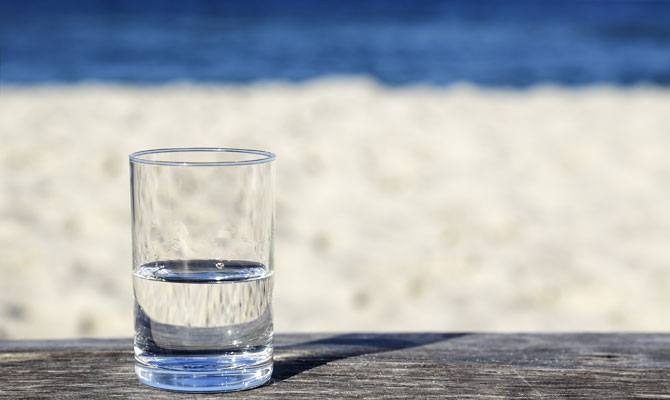Seawater Comes Ashore
This is one in a series of stories; visit The Daily Meal Special Report: Water for more.
"Water, water, every where, / Nor any drop to drink" — that was the plaint of the ill-starred sailor in Samuel Coleridge's The Rime of the Ancient Mariner when his ship was becalmed in southern waters. The water everywhere, of course, was the ocean, and there was nothing to drink because it was, well, sea water. Sea water typically contains about 35,000 parts per million of salt (for comparison, fresh water contains closer to 1,000 parts per million).
Why can't we drink salty water? Energy drinks and other beverages are often spiked with salt, and then of course there's the rim of our margarita — but we all figured out, presumably pretty early on, that actual salt water was not something we could stomach. Why? First of all, because it tastes terrible — so terrible that the so-called "cooking wine" sold in stores that don't have the right to sell actual wine is rendered unappealing with a hefty dose of salt. And of course it doesn't slake your thirst — the salt just makes you thirstier. Worst of all, though, salt water in the concentration found in the oceans is toxic. Our kidneys need fresh water to dilute the salt in our bodies, and if we ingest too much salt, even the fresh water we contain turns salty and out kidneys can't function — and pretty soon, we can't function either.
There's plenty of water on earth; the problem is that about 96.5 percent of it is in the oceans, and vast portions of the globe are severely water-deprived. Perhaps the most water-stressed region is the horn of Africa — but freshwater stocks are steadily shrinking in North Africa, Spain, southern Italy, Australia, northern China, the Middle East, parts of India and Pakistan, and, yes, in California. Without sufficient water, nothing grows, and plants, animals, and people die.
The obvious solution to this problem is to convert seawater into fresh water, and we've been trying to do that for a long time. Some scholars point to a passage in the Old Testament in which Moses turned salt water sweet. The Romans, it is said, developed a method of filtering salt out of water through porous clay. When he was Secretary of State back in the 1790s, Thomas Jefferson sent instructions for boiling seawater to produce emergency drinking water on all U.S. ships. By the middle of the twentieth century, virtually all ships had desalination facilities onboard. The first full-scale desalination plant in the world was built on the Caribbean island of Curaçao in 1928. Today there are at least 15,000 such facilities around the world, the largest housed in the Middle East (though the largest inland plant is in El Paso, Texas).
Distillation — the process of boiling off and collecting the water while leaving the salt and other minerals behind — is the simplest method of desalination. It is also extremely energy-inefficient, an issue that means little in the oil-rich Middle East, but is a major problem in most regions. The preferred method is reverse osmosis, a complex procedure that pumps saltwater through a membrane assembly. While more energy-efficient than distillation, it is still an expensive process. Alternate methods of removing salt from water include solar desalination, still under development; a process using atmospheric pressure instead of heat to induce evaporation; an ion-exchange process; and a super-thin filter developed at Lockheed Martin last year, which apparently requires only a low-pressure pump to function.[pullquote:right]
Maybe the most interesting innovation in the field, though, is the seawater greenhouse, developed by Charlie Paton in the early 1990s. This is no mere desalination facility; it is a gigantic greenhouse with a front wall that functions as an evaporator. Seawater is pumped to the evaporator, where it drips down over a kind of screen, cooling and humidifying air blown through by fans. The damp air provides moisture for the plants inside, which flourish beneath a roof that lets through sunlight and traps infrared heat. Seawater heated on the roof is again evaporated and the hot air produced passes through a condenser cooled by the new seawater, producing more fresh water. Humid air expelled from the greenhouse by the exhaust system provides further benefits to crops planted downwind, and biomass residues of the process can be used to enrich the soil.
There are currently seawater greenhouses in operation in Oman, Abu Dhabi, the Canary Islands of Gran Canaria and Tenerife, and South Australia. Seawater greenhouses are also a key part of an initiative called the Sahara Forest Project, which seeks to supply fresh water, food, renewable energy, and "green" jobs in arid desert regions. The first pilot facility opened in Qatar — a country that gets about three inches of rainfall per year and that imports almost 95 percent of its food — in late 2012, and has thus far been judged a success. The Project's design is meant as an analogue to natural ecosystems, in which waste material from one component fuels or feeds another, and so on.
There is clearly much work to be done in the field of converting saltwater into something we can drink and use to grow our crops — and doing it sustainably. As aquifers around the world deplete and climate-change drought threatens even regions that once were fertile, further research in this area has become, quite literally, vital. As Charlie Paton pointed out to the Global Water Forum earlier this year, "we are not short of water, it is just in the wrong place and too salty."
